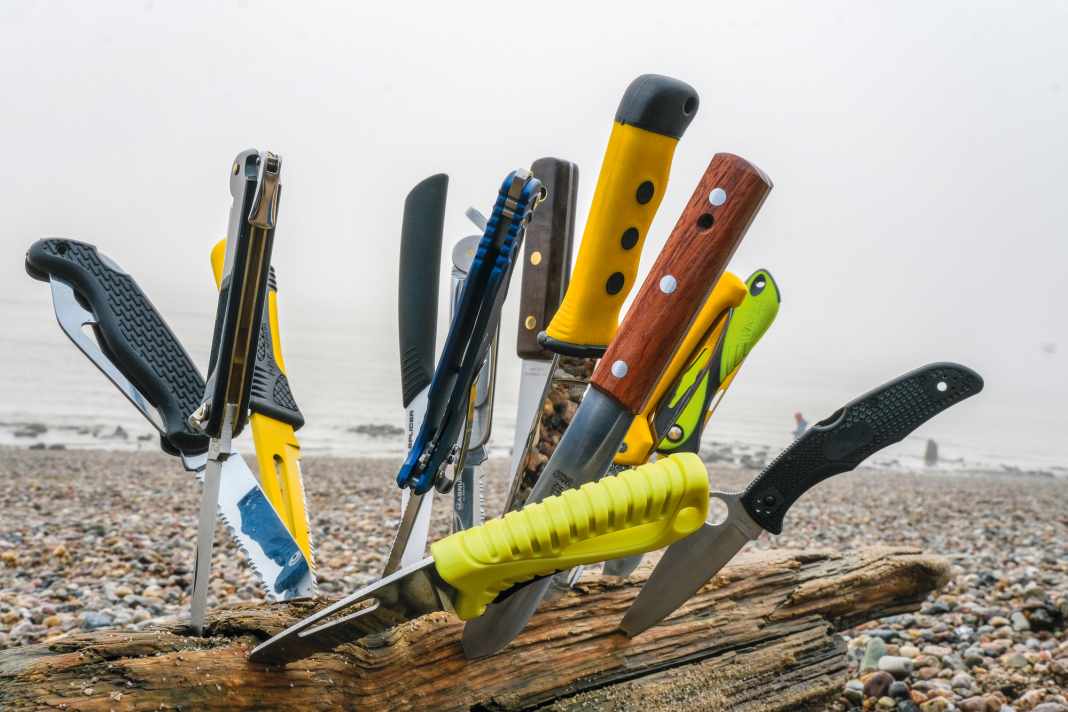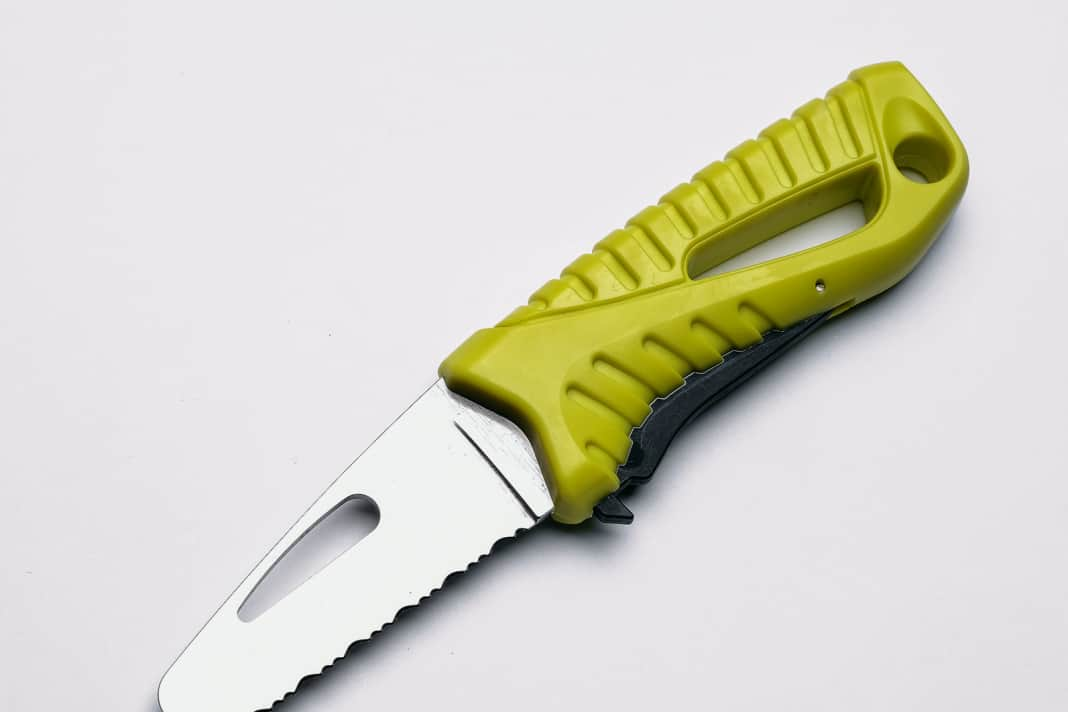





You can somehow cut a bread roll in two with any cutting tool, but sailing knives should be able to do much more on board, such as cutting ropes to length. This is where the differences become apparent. Depending on the material of the line, the result can go either way: If it takes a long time and the line is completely frayed afterwards, it would be time to regrind it - or think about buying a different knife.
The test field for the sailing knives
For the test, we have collected a wide variety of new sailing knives: From pocket knives with folding blades to sailor's knives specially designed for cordage work, a knife specially designed for splicing work and emergency knives, everything is included. The pocket knives include two models from Mac, the Boat2 and the B91/5, the Wichard Offshore and the Pacific Salt 2 from Spyderco. A sailor's knife is represented, the Mac Nostromo. It has a serrated edge on half of the blade, which also makes it ideal as an emergency knife. The D-Ceramic C20 from D-Splicer is specially designed for rope work and, as the name suggests, has a ceramic blade. The Wichard emergency knife and the Rescue Knife round off the selection.
Material, blade and grind of the sailing knives
The differences in the area of application of the sailing knives are also reflected in the appearance of the knives: the blades are hinged or fixed, different materials are used and various grinds are represented, from smooth to wavy to serrated. The knife from D-Splicer plays a special role - the ceramic blade is extremely sharp, the sharpest in the test. Thanks to the outstanding hardness of the material, it can be expected to stay that way for a long time - if the blade doesn't break first. Compared to steel, the material is quite brittle and can burst if the knife falls on hard ground, for example. The Pacific Salt 2 from Spyderco uses H1 steel, a special alloy. This metal is harder than conventional stainless steel, but should not rust, even when in direct contact with salt water. However, the special material is also reflected in the highest price in the test.
The rest of the test field is equipped with stainless steel blades, which is particularly useful for emergency knives, as they may be attached to the mast or in the cockpit and are therefore always exposed to the weather and overflowing seas. The differences in the sharpening of the blade also result from the use: a smooth, sharp blade is required to cut ropes cleanly. This can also be easily sharpened by the user.
Blades with serrated edges or saw teeth are unsuitable for proper cuts on the cutting board, but have advantages when cutting a line. In the test, we tried this with a slightly taut line. Ideally, the cordage could be cut with one pull. Here, smooth blades, which had previously cut perfectly, suddenly lost out. The Pacific Salt 2 was not convincing, even though it is extremely sharp - it simply slipped too quickly.
The saw teeth of the Wichard emergency knife, on the other hand, showed what they are capable of here, although it was not even able to cut through the Dyneema on the cutting board. The pointed shafts and teeth prevent the knife from simply sliding along the line; each tooth bites a few fibres, so even a relatively short blade can successfully cut cordage. The biggest difference between the knives tested is the design.
Folding or upright blade
The pocket knives have a folding blade, whereby another important feature is whether it can be locked in place. This is the case with the Pacific Salt 2 and the Offshore from Wichard. The Pacific Salt 2 can also be opened with one hand. It was not possible to lock the blade on the Mac models. An unsecured blade can lead to cuts if it is folded unintentionally.
This risk does not exist with the other models with a fixed blade. However, the design has disadvantages: the knives are also quite bulky when not in use and require a special sheath to cover the blade. In the case of the emergency knives, this is a robust quiver made of hard plastic with fastening eyelets. Wichard's emergency knife is even locked in the sheath; it can be released and removed by pressing a button on the handle. However, this safety lever also popped out of the handle once during the test, but was able to be re-engaged together with the spring.
Extras galore
Other features such as a marlin spike, shackle opener, can opener etc. were not evaluated in the test, as the test field was very heterogeneously equipped with them.
The main focus of the evaluation was clearly on cutting. The handling of the knife was assessed: How often does the user have to saw back and forth to cut the line? The less, the better. Then the quality of the cutting edge was assessed - the more frayed, the worse. Success in cutting a line was also included in the assessment. The highest score was awarded if this was done in one pull.
A total of 90 out of 100 points were awarded for the cutting tests alone; the price was also included in the assessment with 10 per cent. The models Boat2 and B91/5 from Mac and the Ceramic knives from D-Splicer real favourites with prices around 20 euros. The only clear outlier here is the Spyderco product at over 140 euros.
The winner among the sailing knives
The absolute winner is the atypical ceramic knife - closely followed by the classic sailor's knife. The Offshore from Wichard also receives five stars, the Pacific Salt 2 four. The rescue knives are almost on a par, with the Toplicht model scoring a few points higher. The Nostromo is a real all-rounder thanks to its halved blade with both a smooth and serrated edge. The Boat2 and the B91/5 were not really convincing, as they did not work well on the cutting board or when cutting the line.
The knife from D-Splicer belongs more in the rigging box and should be reserved for splicing work. The situation is similar with the classic sailor's knives. However, the sheaths of both can also be attached to the belt. Practical products for everyday use on board are the Pacific Salt 2 and the Offshore from Wichard, which also has a marlin spike and shackle opener. Sailors are spoilt for choice. But it doesn't have to be just a knife on board.
This is how we tested
In the cutting test, each knife had to cut five times through a 14 millimetre diameter polyester core braid, then five times through a Dyneema braid. The cordage was placed on a cutting board without tension. The cutting quality and knife handling during cutting were assessed. In order to do justice to the emergency knives, a slightly tensioned line was then cut, which produced different results than on the cutting board.
Test results of the sailing knives in detail
D-Ceramic C20 from D-Splicer
- Distribution: lindemann-kg.de




Offshore from Wichard
>> e.g. available here




Emergency knife from Wichard
>> e.g. available here




Sailor's knife Nostromo from Mac
>> e.g. available here




Sailor knife B91/5 from Mac
- Distribution: navyline.com




Sailing knife Boat2 from Mac
- Distribution: yachticon.com




Pacific Salt 2 from Spyderco
>> e.g. available here




Rescue Knife from RRK
- Distribution: sostechnik.com





